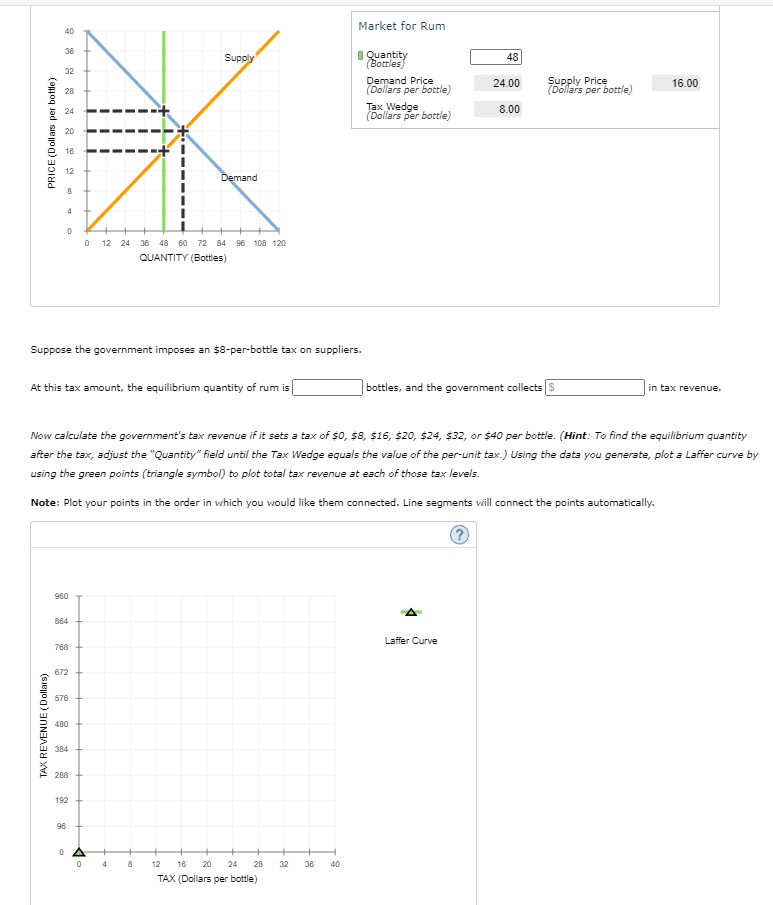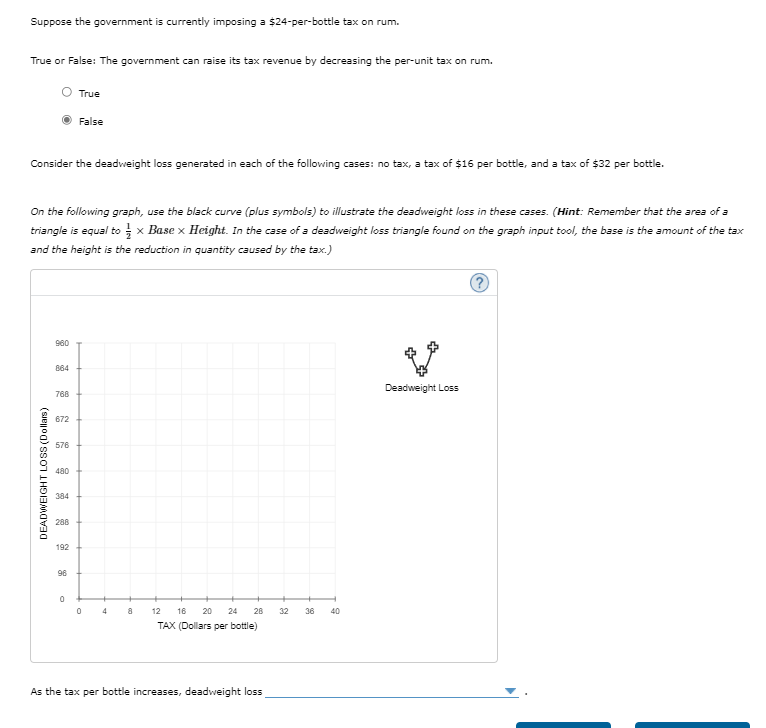36 Supply I Quantity (Bottles) 48 32 Demand Price (Dollars per bottle) Şupply Price (Dollars per bottle) 24.00 16.00 28 Tax Wedge 8.00 24 (Dollars per bottle) 20 16 12 Demand 4 O 12 24 36 48 60 72 84 s6 108 120 QUANTITY (Bottles) Suppose the government imposes an $8-per-bottle tax on suppliers. At this tax amount, the equilibrium quantity of rum is [ ] bottles, and the government collects in tax revenue. Now calculate the government's tax revenue if it sets a tax of $0, $8, $16, $20, $24, $32, or $40 per bottle. (Hint: To find the equilibrium quantity after the tax, adjust the "Quantity" field until the Tax Wedge equals the value of the per-unit tax.) Using the data you generate, plot a Laffer curve by using the green points (triangle symbol) to plot total tax revenue at each of those tax levels. Note: Plot your points in the order in which you would like them connected. Line segments vill connect the points automatically. 960 PRICE (Dollars per botte)
36 Supply I Quantity (Bottles) 48 32 Demand Price (Dollars per bottle) Şupply Price (Dollars per bottle) 24.00 16.00 28 Tax Wedge 8.00 24 (Dollars per bottle) 20 16 12 Demand 4 O 12 24 36 48 60 72 84 s6 108 120 QUANTITY (Bottles) Suppose the government imposes an $8-per-bottle tax on suppliers. At this tax amount, the equilibrium quantity of rum is [ ] bottles, and the government collects in tax revenue. Now calculate the government's tax revenue if it sets a tax of $0, $8, $16, $20, $24, $32, or $40 per bottle. (Hint: To find the equilibrium quantity after the tax, adjust the "Quantity" field until the Tax Wedge equals the value of the per-unit tax.) Using the data you generate, plot a Laffer curve by using the green points (triangle symbol) to plot total tax revenue at each of those tax levels. Note: Plot your points in the order in which you would like them connected. Line segments vill connect the points automatically. 960 PRICE (Dollars per botte)
Principles of Microeconomics
7th Edition
ISBN:9781305156050
Author:N. Gregory Mankiw
Publisher:N. Gregory Mankiw
Chapter8: Application: The Cost Of Taxation
Section: Chapter Questions
Problem 10PA
Related questions
Question
Governments often place so-called sin taxes on goods or services such as cigarettes and alcohol. These kinds of taxes are popular with politicians because they are usually more palatable to voters than income taxes.
To understand the effect of such a tax, consider the monthly market for rum, which is shown on the following graph.
NOTE: the fill in blank options are (increases by a greater and greater amount, increases and then decreases, or increases at a constant rate)

Transcribed Image Text:Market for Rum
40
36
Supply
I Quantity
Bottles)
48
32
Demand Price
(Dollars per bottle)
Supply Price
(Dollars per bottle)
24.00
16.00
28
Tax Wedge
(Dollars per bottle)
24
8.00
20
16
12
Demand
4.
O 12 24 36 48 60
72 84 96 108 120
QUANTITY (Bottles)
Suppose the government imposes an $8-per-bottle tax on suppliers.
At this tax amount, the equilibrium quantity of rum is
bottles, and the government collects S
in tax revenue.
Now calculate the government's tax revenue if it sets a tax of $0, $8, $16, $20, $24, $32, or $40 per bottle. (Hint: To find the equilibrium quantity
after the tax, adjust the "Quantity" field until the Tax Wedge equals the value of the per-unit tax.) Using the data you generate, plot a Laffer curve by
using the green points (triangle symbol) to plot total tax revenue at each of those tax levels.
Note: Plot your points in the order in which you would like them connected. Line segments will connect the points automatically.
980
864
Laffer Curve
768
672 +
576
480
384
288
192 +
96
0 4
12 16
20
24
28
32
36
40
TAX (Dollars per bottle)
TAX REVENUE (Dollars)
PRICE (Dollars per bottle)

Transcribed Image Text:Suppose the government is currently imposing a $24-per-bottle tax on rum.
True or False: The government can raise its tax revenue by decreasing the per-unit tax on rum.
True
False
Consider the deadweight loss generated in each of the following cases: no tax, a tax of $16 per bottle, and a tax of $32 per bottle.
On the following graph, use the black curve (plus symbols) to illustrate the deadweight loss in these cases. (Hìnt: Remember that the area of a
triangle is equal to x Base x Height. In the case of a deadweight loss triangle found on the graph input tool, the base is the amount of the tax
and the height is the reduction in quantity caused by the tax.)
960
864
Deadweight Loss
768
672
576
480
384
288
192
96
4
8
12 16 20
24
28
32
36
40
TAX (Dollars per bottle)
As the tax per bottle increases, deadweight loss
DEADWEIGHT LOSS (Dollars)
Expert Solution
This question has been solved!
Explore an expertly crafted, step-by-step solution for a thorough understanding of key concepts.
This is a popular solution!
Trending now
This is a popular solution!
Step by step
Solved in 2 steps with 3 images

Knowledge Booster
Learn more about
Need a deep-dive on the concept behind this application? Look no further. Learn more about this topic, economics and related others by exploring similar questions and additional content below.Recommended textbooks for you

Principles of Microeconomics
Economics
ISBN:
9781305156050
Author:
N. Gregory Mankiw
Publisher:
Cengage Learning

Principles of Macroeconomics (MindTap Course List)
Economics
ISBN:
9781285165912
Author:
N. Gregory Mankiw
Publisher:
Cengage Learning

Principles of Economics (MindTap Course List)
Economics
ISBN:
9781305585126
Author:
N. Gregory Mankiw
Publisher:
Cengage Learning

Principles of Microeconomics
Economics
ISBN:
9781305156050
Author:
N. Gregory Mankiw
Publisher:
Cengage Learning

Principles of Macroeconomics (MindTap Course List)
Economics
ISBN:
9781285165912
Author:
N. Gregory Mankiw
Publisher:
Cengage Learning

Principles of Economics (MindTap Course List)
Economics
ISBN:
9781305585126
Author:
N. Gregory Mankiw
Publisher:
Cengage Learning

Principles of Economics, 7th Edition (MindTap Cou…
Economics
ISBN:
9781285165875
Author:
N. Gregory Mankiw
Publisher:
Cengage Learning

Essentials of Economics (MindTap Course List)
Economics
ISBN:
9781337091992
Author:
N. Gregory Mankiw
Publisher:
Cengage Learning

Principles of Microeconomics (MindTap Course List)
Economics
ISBN:
9781305971493
Author:
N. Gregory Mankiw
Publisher:
Cengage Learning